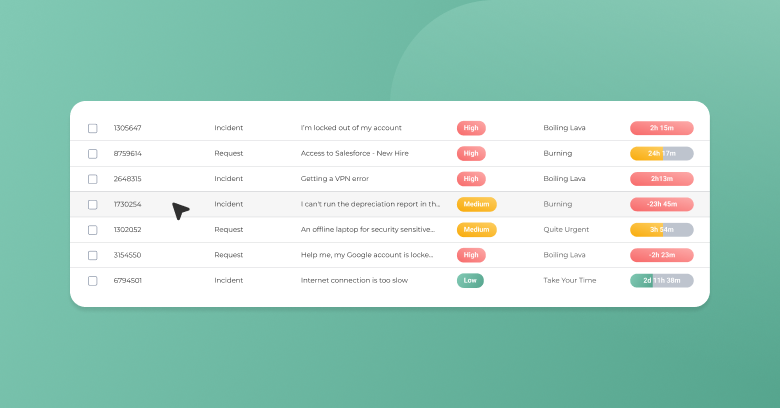How to Help an Angry User in 5 Easy Steps

When you work on a service desk, calls from angry users can be very hard work, not least because of the way we’re likely to feel about them. Being at the other end of an angry phone call or email, is never pleasant, and being confronted by an angry user can be very trying. What’s worse is that while managing the call is our responsibility, resolving the issues may not be. So what can you do to help a customer when they are so angry? How can you get past the anger so you can help resolve their problem? And how can you manage your own feelings?
In my years in the IT industry, I have had to deal with many angry users, and customers. Here are some of the things that I have found effective.
1. Accept that the User Is Entitled to Their Anger
The first thing you need to do is to accept that the caller is entitled to their anger. Even if you KNOW that the user is wrong, they are unlikely to be angry for no reason. So, listen to what they have to say, and try to understand why they feel angry. If you can work out what it is about the situation that has resulted in a furious user, rather than one just asking for help, you will have a much better idea of what you can do to help. For example, the user may be angry because a minor IT failure has resulted in a major business impact. If you treat this as a minor issue, then it’s not surprising that they get angry.
2. Don’t Get Defensive
This is, of course, much more easily said than done. It is very easy to get defensive, and respond angrily. But if you try to justify the situation, or to tell the caller why they are wrong, the caller is likely to get even angrier, and it will take even longer to achieve the calm you need to deal with the problem.
What you need to remember is not to take the anger personally. You are the target of this anger because you are a representative of the company. The caller is angry with the company, not with you.
Something that I have found useful in these circumstances is to remember a time when I have felt angry with a service organization. I think about what reaction I wanted from the person on the other end of the phone. I try hard to empathize with the angry user, it really could have been me on some other occasion.
3. Listen Actively
The first two points I have made are about managing your own emotional responses. But what do you actually do in this situation?
In my experience, the most important thing to do is to listen and to demonstrate that you are genuinely trying to understand. Listen patiently and give the user enough time to say what they need to. Don’t try and cut them short, but allow them to express their feelings. Don’t try to justify the situation, or to tell the user why they are wrong, simply listen to what they have to say, and listen to the emotions and feelings as well as the words. Show that you understand how they feel, as well as the technical details of what has happened. One way to do this is to repeat back what you’ve heard, and ask for confirmation that you have understood correctly – not just about the technical situation, but also about the anger and the reasons for it. Remember that it will help if you use the caller’s name when you talk to them, since people tend to respond much better when addressed by name.
Another way to demonstrate your understanding is to offer sympathy, and an apology, even if you don’t think you’re really in the wrong. BUT be careful. Make sure you’re sincere in your apology, since insincerity is likely to be recognized and resented! I know this sounds contradictory. Surely, it’s impossible to apologize sincerely if you don’t think you are in the wrong? However, if you accept that the user really is entitled to their anger, then you should find that you can offer a sincere apology.
Let’s look at an example. Suppose a user is complaining because they have had to wait 2 hours for you to call them, but the SLA says you don’t have to call back for 4 hours. Of course, they are technically in the wrong. Nevertheless, by listening actively you will have gained a real understanding of the impact this has had on them, and this should enable you to empathize and to offer a genuine apology. It won’t hurt you to say “I am very sorry that we didn’t respond any sooner. I understand the impact this has had on you. Let me try to help put things right here.”
One piece of advice that I have found helpful is to smile while you are talking to the user. You may not notice the difference, but if you smile then it changes your voice, and the user will respond better to what you have to say.

4. Own the Issue
When you take a call from an angry customer, take personal ownership of the issue, even if you would normally pass calls on to another team. Try to ensure that the customer’s issue is handled properly from this point on. If necessary, escalate the situation to your management to get permission to deviate from normal procedures so that you can facilitate this. If you can provide excellent service from this point on, you have a chance not just to salvage the organization’s relationship with the customer but to actually improve it.
Tell the user that you are going to own the issue, and then make sure that you really do own it. It often helps if you ask the user what they would like to happen next. If possible manage the issue the way the customer wants. When that’s not possible, it’s best to be honest and straightforward. Tell the customer what the limitations are now, before they go away with an expectation that you can’t meet. I once had a problem with an organization that delivered a faulty product. I phoned to complain and the person who answered promised to get back to me within 24 hours with a resolution. When they took ownership of the problem, I felt much better. But although I waited patiently for them to call me back, the call didn’t happen! When I phoned them back two days later I was very angry.
As you progress the issue, you must make sure the customer is regularly updated. Talk to them about how often you will update them, and how you will do this, and then make sure you do what you have agreed.
5. Follow Up
After the issue has been resolved you should contact the user again. This is your opportunity to start building a new, healthier, relationship with that user. Make sure they are happy with the resolution, and show them that you care about the service you deliver, and about how they feel.
Conclusion
However good our services are, there are always going to be some users who aren’t satisfied. And sometimes they will get angry with us. One of the things that distinguishes a great service organization is how they manage that situation. You can make it worse by telling the user that they’re wrong, and they’re not entitled to feel angry, or you can acknowledge that they are entitled to their anger and do what it takes to resolve the situation.
As always, please let me know when you try the ideas in my blog and share how well they worked for you.
Did you find this interesting?Share it with others:
Did you find this interesting? Share it with others:








